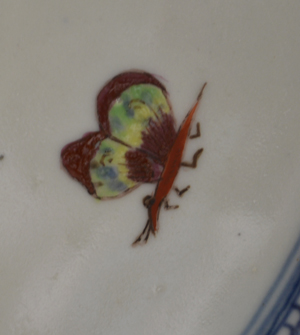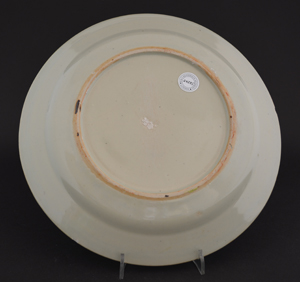
DOCCIA c.1745 Italian Hard-Paste Porcelain
An 18th Century Doccia Blue and White Porcelain Plate c.1745. Painted in Imitation of a European Engraving but in the Chinese Style with a Rosa Canina or Dog Rose. The Over-Glaze Enamel Insects (Probably) Decorated at the Doccia Factory, See References Below.
SOLD
- Condition
- Damaged : there is a large star crack to the center and a rim crack. These have been cleaned and sealed. A kiln mark to the base has been crudely filed down.
- Size
- Diameter : 23.4 cm (9 1/4 inches).
- Provenance
- N/A
- Stock number
- 24285
- References
- For two Doccia with over-glazed decoration of this type see : La Manifattura Toscana Dei Ginori, Doccia 1731-1791 (Edited by Maria Giulia Burresi, Pacini, 1998 pages 65 and 127, plate 37 and 38. (I would like to thank Oliva Rucellai from the Meseo di Doccia for helping confirm the decoration is most probably Doccia and supplying us with this reference). For a blue and white porcelain Doccia bowl with a `thorny rose` see : The Victoria and Albert Museum Collection, Amici di Doccia, Quaderni VII-2013, page 49, plate 24. The author states "In the inventory that was drawn up at Doccia in 1757 after the death of Marquis Carlo Ginori the motif was defined as "alla rosa blu" (with a blue rose) or "alla rosa caniana" (with a dog rose).
Information
Doccia Porcelain :
The Doccia Porcelain factory was located at Doccia near Florence, it was started by Marchese Carlo Ginori (1702–1757), who was a gifted and enlightened politician. He reclaimed the marshes of cecina on the Tuscan coast for use in agriculture and even introduced goldfish from China to the Austrian court. But his great passion was for porcelain, his factory at Doccia started in 1735, although the early period was experimental. Commercial production didn`t start until the early 1740`s, the factory is still in production today. Carlo Ginori shared Augustus the Strong`s love of large sculptural ceramics, wonderful large white porcelain figures and groups were produced, but the factory`s main output was functional porcelain, tea and coffee services as well as dinner services, fork and knife handles, vases, bottle coolers and many other objects. The Doccia factory sometimes used a hybrid hard-paste, the so-called Masso Bastardo. The paste is somewhat grey, frequently showing `firing cracks`. The lead-glaze that was used in the 18th century is also rather grey, sometimes this greyness can be quite pronounced, the tin-oxide glaze can sometimes have an orange-peel effect caused but tiny burst bubbles, this gives a slightly dull appearance. Towards the later part of the 18th century a fine cold white paste was developed for finer quality pieces. The Doccia factory is especially important for the introduced a new technique called Stampino in the 1740`s, this is the earliest attempt at mechanical decoration on European porcelain, the technique involves a type of stencilling in blue and white.



